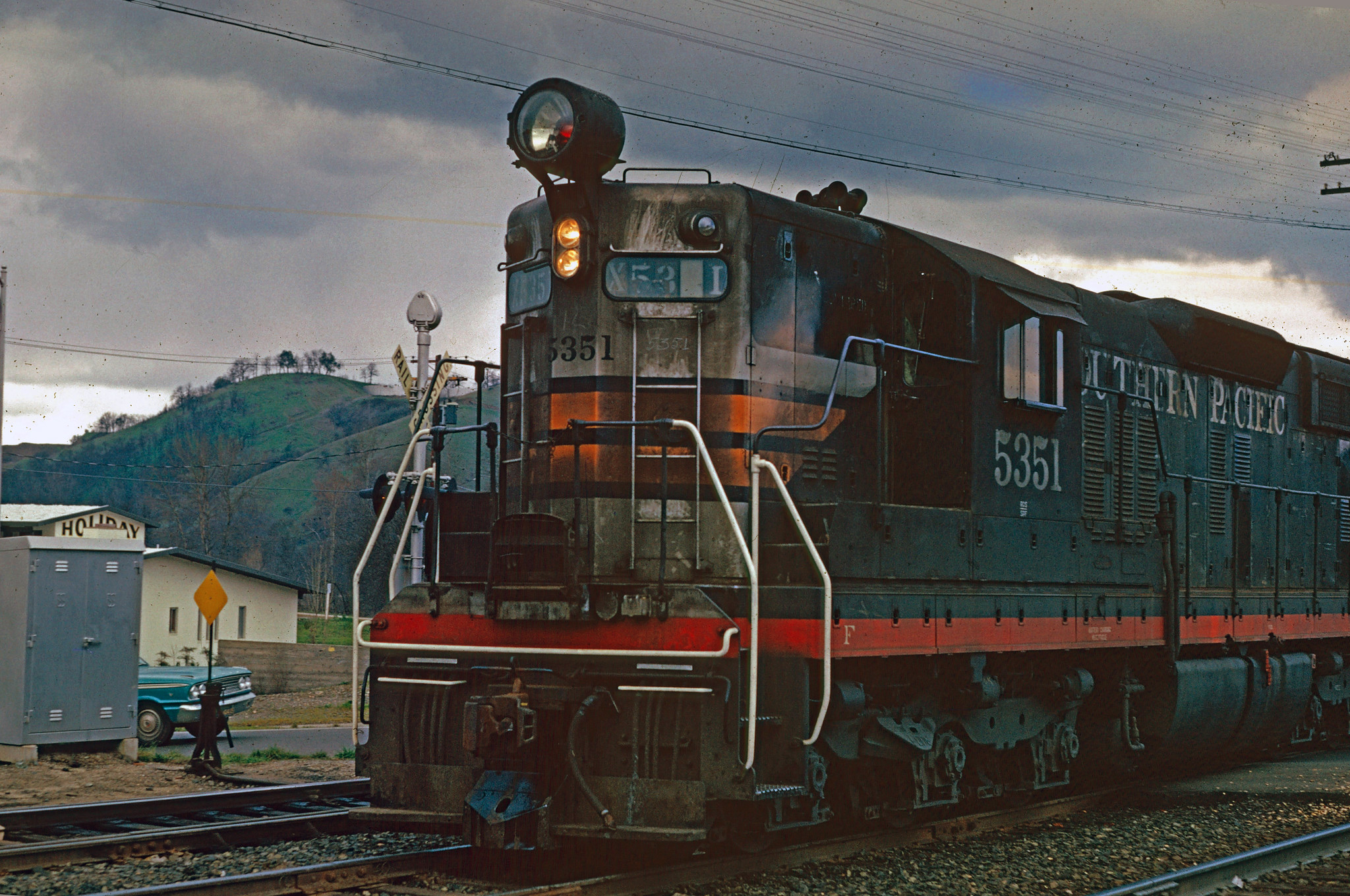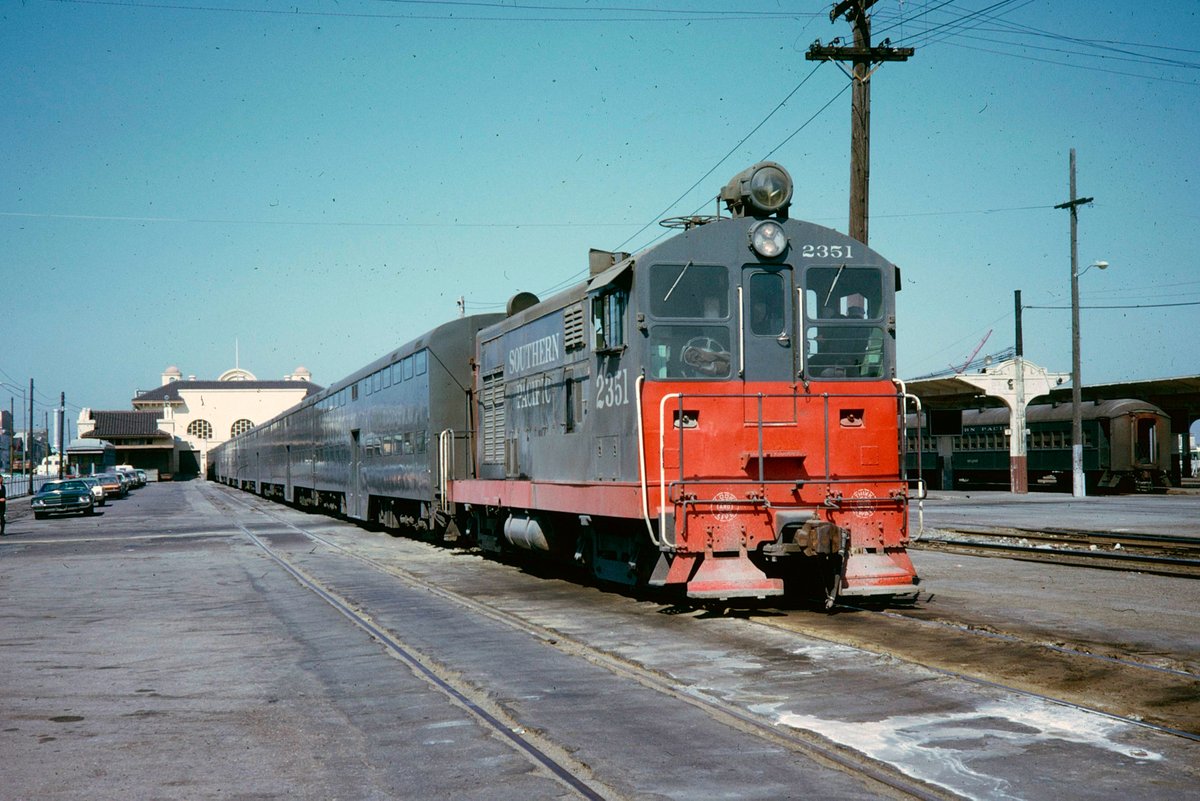
NickD
MegaDork
8/1/22 12:55 p.m.
General Motors' "Train Of The Future" a decade later in a much more mundane setting, running commuter service in the Beverly neighborhood of Chicago in 1964. GM's Aerotrain was a part of the lightweight train craze that was supposed to save intercity rail, and used modified GMC bus bodies on a new frame with a single axle on each end. They were pulled by an EMD LWT-12 power car, which was basically an SW1200 under the automotive-inspired aluminum skin but with 100mph gearing and an unpowered single axle rear truck. Oddly, GM, along with other manufacturers of lightweight trainsets, kept hammering the point that light weight automatically equaled better ride quality, at the same time that they were saying that Cadillacs and Buicks rode better because of their greater weight. The two demonstrator Aerotrain sets took off on a tour across the US. The first set spent almost a year on the PRR, operating the New York City-Pittsburgh Pennsy, later shortened to Philly-Pittsburgh. The second set spent a brief amount of time on the ATSF, running between LA and San Diego, but was found to be too underpowered and often required helpers on grades. It was then sent to the New York Central, where it ran between Chicago and Detroit and then Chicago to Cleveland, then was sent to Union Pacific. Union Pacific had the same issue as ATSF, often having to assign a helper unit to get the underpowered LWT-12 over hills. PRR and UP both sent the Aerotrains back to EMD, citing a backbreaking ride-quality and an underpowered power car, even after EMD regeared them from 100mph to 80mph to give a little more pulling power. Rock Island had purchased a separate LWT12 power car and mated it to ACF Talgo single-axle coaches, and was made a fire-sale offer for the Aerotrain demonstrators, which they took EMD up on. Originally run between Chicago and Peoria as the Jet Rocket, the route was shortened to Chicago to Joliet, and then later on the three were demoted to commuter duty. They didn't make a helluva lot of sense in commuter duty either, since they were slow to accelerate and the coaches only had doors on one end, meaning ingress and egress took longer. The RI physical plant was also deteriorating pretty bad, and combined with the notoriously poor ride of the Aerotrain, resulted in a horribly uncomfortable ride.


NickD
MegaDork
8/1/22 2:11 p.m.
Rock Island assigned road numbers #2 and #3 to the former Aerotrain demonstrators, but CRI&P #1 was the solo LWT-12 that was purchased and mated with the American Car & Foundry Talgo trainsets. The Talgo cars were visually distinct in that they didn't have the diagonal windows of the GM Aerotrain cars, and they had a single axle per coach at the rear of the car, with the front of the car supported by the tail of the car ahead of it. The Talgo cars were also used on the Xplorer and the Dan'l Webster


NickD
MegaDork
8/1/22 2:59 p.m.
The first Aerotrain demonstrator during it's tenure at the Standard Railroad of the World. Shown departing Altoona in August of 1956. It is too bad that it was a complete failure, as it really was quite a striking machine.


NickD
MegaDork
8/1/22 3:01 p.m.
PRR #1000 at Newark, NJ on March of 1956, just one month after entering service. Note the skirting over the lead and trailing trucks that is missing in the photos of the Aerotrains by the time they ended up on the Rock Island. Likely they were removed by maintenance crews to allow them to service the axle journals easier.


NickD
MegaDork
8/1/22 3:03 p.m.
Funny that the Aerotrain was rapidly consigned to the dustbin of history, but the old stone Rockville Bridge is still in active service.

In reply to NickD :
I'd never considered it before now, but with the locomotive cab above the roofline of the coaches it must have given a unique view for the crews.

NickD
MegaDork
8/1/22 10:54 p.m.
In reply to Pete Gossett (Forum Supporter) :
What was weird was that the back of the cab didn't have any glass, so rearward visibility was about the same as an E- or F-Unit. Of course, the LWT-12 was pretty much permanently paired with its trainset, so it wasn't like it was ever doing any switching or doing many reverse moves.
In reply to NickD :
I noticed that too. It seems like forward visibility might have also been worse with the longer nose & added height of the cab?

NickD
MegaDork
8/2/22 10:45 a.m.
In reply to Pete Gossett (Forum Supporter) :
Probably would have been a little worse for up-close and thrown off judging distances as well, but again, they weren't doing any switching or close-up work with it, the front coupler was mostly just for moving it dead-in-tow or adding a helper.
I know SP crews had issues with the tall-cab Alco C415s that SP ordered. Not only was the roof of the cab very tall, but the cab floors on C415s were quite a bit above the frame, as there was a driveshaft run underneath from the prime mover to the compressors and radiator cooling fans. Crews said sitting up so high made it hard to judge the distance from the cab to the ends of the locomotive, and so they made a lot of hard couplings with them, compared to the end cab Sw1500s that they were also using at the same time.

Note the big trashcan sized lamps that SP was so fond of on SW8 #1123

NickD
MegaDork
8/2/22 12:54 p.m.
A very grungy Southern Pacific SD9 in "Black Widow" livery with the big "ash can" Mars light. Those with red bulbs or red lenses were used if an engine was running light without a caboose, or if there was a situation that forced the train into emergency braking they would automatically kick on. The idea for the automatic engagement was that if there was a derailment and cars were potentially on an adjacent track, then an oncoming train would see the flashing red light and know to come to a stop, check to see if it was safe, and then proceed forward at reduced speed. They also equipped clear lens and clear bulb Mars lights to passenger locomotives as a safety measure for crossings.


NickD
MegaDork
8/2/22 1:42 p.m.
Big SP Train Masters on the Bay Area Commute, still in "Black Widow" colors with a big Mars light between the numberboards. SP ordered the Train Masters with steam generators, but originally tried assigning them in freight service out of El Paso. Those big opposed-piston naval engines didn't appreciate the hot, dry, sandy climate and so SP reassigned them to commuter service, where their 2400hp and 6-axles resulted in a machine that would out-accelerate anything else on the market. Also, the Bay Area was a good fit, as the F-M 38D8 1/8 engines were optimized for cool, moist air at atmospheric pressure and there were plenty of Navy-trained Fairbanks-Morse mechanics in the Bay Area, due to the proliferation of naval facilities in the area.


NickD
MegaDork
8/2/22 2:00 p.m.
A Fairbanks-Morse H-12-44 switcher with the big "ash can" lights spotting cars at San Fran's 3rd & Townsend depot. You can also just see the weird Bendix-King "wagon wheel" antenna, to the left and down of the Mars light, that SP was rather fond of.


NickD
MegaDork
8/2/22 2:06 p.m.
An SP Baldwin S12 switcher at Roseburg, Oregon with the weird enclosed red Mars light that the S12s came with. There was a similar binocular-like enclosure mounted on the roof of the cab.


NickD
MegaDork
8/2/22 2:42 p.m.
A rear view of one of those SP Baldwin S12s showing the nacelle for the headlamp and red Mars lamp. Taken at Taylor Yard in San Fran, the S12, along with the neighboring Geep and U-Boat, have all been "blue-flagged". When equipment needed to be worked on, a blue flag was inserted into the coupler on both ends as an alert that the equipment was undergoing work and was not to be moved until the flags were removed by the person performing repairs. By this date, the old blue flag on a wooden stick had been replaced with metal signs that attached to the handrail. Anecdotally, I actually got to see something blue-flagged in-person when I went to the Wiscasset, Waterville & Farmington, there was a car that the handbrakes were dragging on, and they had to blue-flag the whole consist while a crewmember got underneath and backed off the brake adjuster.


NickD
MegaDork
8/2/22 2:51 p.m.
SP SD7 #2704 and what looks like a GE U30C wait for permission from the Valley-Mountain dispatcher in Bakersfield to drift back down the mountain after helping an eastbound manifest. The big "ash can" gyrating lights actually moved the whole bulb, rather than gyrating mirror assemblies like in the later and smaller units, making them more internally complicated. Regulations required that all the lights that a locomotive were equipped with be functioning, and so as the gyrating lights, which weren't legally required to be equipped on a locomotive, failed, theyh were removed or replaced with the much smaller, simpler assemblies. The #2704 is still holding onto her big "ash can" light.


NickD
MegaDork
8/2/22 5:01 p.m.
SP's oldest named train, the Del Monte, crossing the so-called Earthquake Bridge due to its proximity to the San Andreas Fault. GP9 #3001 has the smaller, simpler red Pyle National "Gyralite" that replaced the huge "ash cans" when they failed and below it is a pair of white sealed-beam lights that would alternate, like modern ditch lights, to get attention at crossings. Then below that are the headlights

There's another train show out there called Trains Unlimited.

NickD
MegaDork
8/3/22 8:57 a.m.
In reply to 914Driver :
I remember there being a Trains Unlimited on PBS(?) when I was a kid, but it was on some goofy schedule or was always getting moved around in the timeslots or something and I would only rarely catch it. I also remember having a really good set of Discovery documentaries on VHS that an uncle taped off of cable for me as a gift when I was young. There was a bunch, Steam Locomotives, Diesel Locomotives, Train Wrecks, Train Robberies, Grand Central Terminal. Those VHSs vanished years ago though.
Love the bloody nose SPs. Your explanation of the red lights was new to me! Awesome info and photos,

NickD
MegaDork
8/3/22 4:26 p.m.
An SP U33C with the "cobra" flashing red light over the cab.


NickD
MegaDork
8/3/22 4:49 p.m.
SP FP7 #6460, with the Mars light (upper) and twin sealed-beam headlamps (nose door) lit up. The "75" in the numberboards is the train number, per SP practice, and that was The Lark, an overnight train between LA and San Fran that last ran in 1968. According to old SP engineers, the Mars lights and Gyralites were a much better warning device than the alternating lamps or flashing ditch lights, because you could literally see a Mars light over the horizon before you saw a train. The downside was they were more mechanically complicated and required maintenance. One SP engineer also said that the lights had a switch you could flip that would pause the light in it's travel, allowing you to basically use it as a spotlight for trackside. He talked about a locale on his normal run where teenagers would frequently park at night, and so when he would come through, if he saw a car with the windows steamed up, he would pause the light on said car and then tie the horn cord down as he went past, much to their annoyance. Also, the structures on the roof are icicle breakers, required on leading passenger power when operating over Donner Pass to protect the dome cars from icicles that built up in tunnels and snow sheds.

Speaking of interesting motive power add-ons, I found a pic of two switchers that were used in grain service. The spark arrestors take up almost the entirety of the hood. It's quite impressive.


NickD
MegaDork
8/4/22 9:41 a.m.
An A-B-B-A set of SP FP-7s prepares to make their evening departure from Oakland, California with the Reno Fun Train.


NickD
MegaDork
8/4/22 11:49 a.m.
SP #6462, the oddball. Although it has had the upper headlight swapped to flashing twin sealed-beams and had a headlight added to the door by this point, the lack of a dynamic braking blower fan over the cab roof, pilot plow or front multiple unit cables are clues that this FP7 didn't originally start life on the Southern Pacific. It was originally delivered to SP subsidiary St. Louis Southwestern, the sole FP7 owned by the Cotton Belt Route, and since it was operating across the warm climate and flatland territory of the southwest and midwest and since the SSW's passenger service was a rather meager affair, it was delivered without the dynamic brakes, front MU cables and pilot plow of the SP. SSW also didn't use the Mars lights that their parent company did, so it just had a nose headlamp. After the Cotton Belt ended passenger service in '65, their passenger diesels were sent west to the SP proper for use on their remaining passenger trains. SP repainted the #306 from the Daylight livery and renumbered it to #6462, but since it lacked the front MU cables and dynamic brakes, it was worthless for their passenger service over Donner Pass. Instead, it was assigned to commuter train service, later having the nose light converted to flashing twin sealed-beams and a regular headlight added to the door. Since it wouldn't be venturing into the rougher, snowier terrain, they didn't bother adding icicle breakers or a pilot plow to the #6462.















































